


Corn was pretty flat on the week, but it did not lack volatility. The war in Ukraine and the constant news make for wild swings on unconfirmed reports such as peace talks and Russian demands. The volatility has caused many headaches, but the volume has decreased, showing that many traders are watching from the sideline and not trading volatile rumors that may or may not be true. The next month of weather will be important as some areas of the US are very dry and will need moisture heading into the spring. Corn export sales were above expectations this week, helping the bounce back Thursday.


Soybeans fell on the week as the news affecting beans is not solely out of Ukraine. South America has had better weather conditions the last couple weeks and forecasted ahead. While the drought conditions did plenty of damage to the crop early on, the improved conditions are good but not great to help out. Bean exports were within expectations this week as beans have traded relatively flat the last couple of weeks.


Wheat’s volatility continued this week as the war in Ukraine continued. Reports of peace/ceasefire talks have been in the news that seems to move markets whenever a new one is reported, but the volatility will continue until there is a resolution. There will still be massive fallout from this war as Ukraine’s infrastructure will be devastated, and sanctions on Russia will be large. Ukraine’s crop year drastically change, and it will be hard to get a full read on the damage until much later. Rain fell on some of the drier areas in the US that grow wheat, but the market did not seem to care. For now, the news will continue to be Ukraine and Russia.
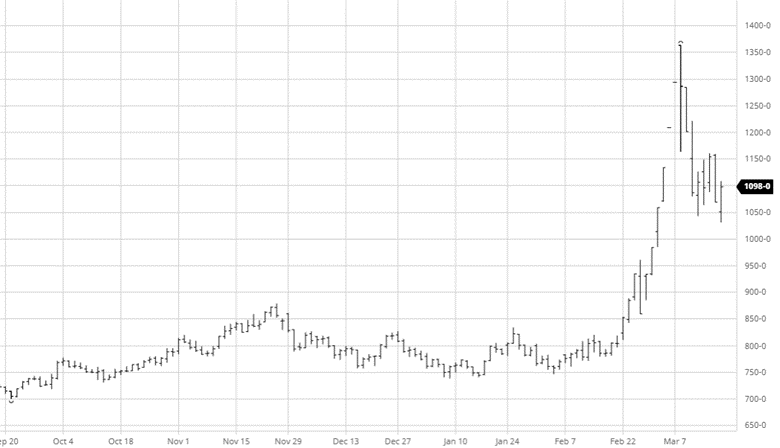

Dow Jones
The equity markets rallied this week as investors aren’t sure if we bottomed but felt the market had fallen enough to be an excellent area to get back in. The fed decided to raise rates for the first time since 2018 raising it a quarter of a point. They also announced to expect six more raises as the year goes on to fight inflation. The market had already priced this news in, and after a short dip down, markets finished the day after the news higher. China has had a new round of Covid lockdowns, which is something to watch.

Podcast
Tune in as biotech guru Dr. Channa S. Prakash discusses everything from Alabama football, genetics as one of the most extensive agricultural advancements, the most significant risk factors to feeding the world over the next 30-50 years, plus everything in between.
Why producing crop plants with a much gentler footprint on the natural resources will help feed the growing population. How 75% of the world’s patents in agriculture gene editing are coming from China. Understanding that trying to impose restrictions on our ability to grow food can be a considerable risk to agriculture. Listen to hear about these topics and more!

Via Barchart.com
Contact an Ag Specialist Today
Whether you’re a producer, end-user, commercial operator, RCM AG Services helps protect revenues and control costs through its suite of hedging tools and network of buyers/sellers — Contact Ag Specialist Brady Lawrence today at 312-858-4049 or [email protected].
 Corn made slight gains on the week with very volatile intraday markets. The Ukraine and Russian news continue to stay in the market and will likely dominate headlines until it ends. Other news worldwide is that South America got rains in southern Brazil and Argentina, with dry central and northern Brazil. Russian officials announced that they would suspend fertilizer exports through the end of the year, presenting a supply crunch across the world. This week’s USDA report was nonexistent in the markets as there were no surprises. As mentioned last week, Ukraine’s corn crop may not get in the ground as only 60% of seed is on farm; this will be important moving forward as world balance sheets get tighter.
Corn made slight gains on the week with very volatile intraday markets. The Ukraine and Russian news continue to stay in the market and will likely dominate headlines until it ends. Other news worldwide is that South America got rains in southern Brazil and Argentina, with dry central and northern Brazil. Russian officials announced that they would suspend fertilizer exports through the end of the year, presenting a supply crunch across the world. This week’s USDA report was nonexistent in the markets as there were no surprises. As mentioned last week, Ukraine’s corn crop may not get in the ground as only 60% of seed is on farm; this will be important moving forward as world balance sheets get tighter.

 Soybeans made small gains this week despite the wild intraday volatility. The USDA trimmed South American production again in this week’s report as they continue to baby step lower to what will be a smaller crop. World edible oil prices were up on the week pulling bean oil and soybeans higher. The Black Sea area’s worry and trade have affected the oils market, not just wheat.
Soybeans made small gains this week despite the wild intraday volatility. The USDA trimmed South American production again in this week’s report as they continue to baby step lower to what will be a smaller crop. World edible oil prices were up on the week pulling bean oil and soybeans higher. The Black Sea area’s worry and trade have affected the oils market, not just wheat.

 Wheat fell hard this week with an expanded limit down the day with a small bounce on Friday heading into the weekend. All the short wheat positions that were getting run over had the opportunity to get out this week with the move down. However, the unknown in eastern Europe and China having its worst winter wheat crop on record means there is still upside with volatility. Friday’s gains were welcome to see after three days of large losses. The cash market will be essential to follow as it will help determine the fair market value.
Wheat fell hard this week with an expanded limit down the day with a small bounce on Friday heading into the weekend. All the short wheat positions that were getting run over had the opportunity to get out this week with the move down. However, the unknown in eastern Europe and China having its worst winter wheat crop on record means there is still upside with volatility. Friday’s gains were welcome to see after three days of large losses. The cash market will be essential to follow as it will help determine the fair market value.


Dow Jones
The equity market fell again this week as continuing war, and another record inflation number was challenging for the market to figure out. While the market seems like it is struggling to make up its mind, there are pockets that are performing alright. The world economic outlook appears to be teetering, and trying to digest what to do with Russia will be a major decider.

Podcast
Tune in as biotech guru Dr. Channa S. Prakash discusses everything from Alabama football, genetics as one of the most extensive agricultural advancements, the most significant risk factors to feeding the world over the next 30-50 years, plus everything in between.
Why producing crop plants with a much gentler footprint on the natural resources will help feed the growing population. How 75% of the world’s patents in agriculture gene editing are coming from China. Understanding that trying to impose restrictions on our ability to grow food can be a considerable risk to agriculture. Listen to hear about these topics and more!

Via Barchart.com
Contact an Ag Specialist Today
Whether you’re a producer, end-user, commercial operator, RCM AG Services helps protect revenues and control costs through its suite of hedging tools and network of buyers/sellers — Contact Ag Specialist Brady Lawrence today at 312-858-4049 or [email protected].
It has been an exciting week in futures as it traded each of the five sessions. There was continued volatility, but March closed virtually unchanged from a week ago. That’s progress. We saw that the CME upped the limits, and we’ll also see an article in the WSJ this week referencing the constant limit moves we have. Notoriety is good. At the same time, there has been a slow creep high in total open interest.
It has been a while since the futures and cash markets were this close. However, we’re not sure the futures market is that close to the cash market after hearing numerous reports of cash trades over $1,400. It looks like the market has paused to take a look.
Lumber has always been an industry that would buy into an uptrend and hedge into a downtrend, and there wasn’t much pre-positioning. The same is in place today where a switch is flipped, and we all see the panic on the buy-side. Then another switch is flipped, and you can’t find a buyer. This doesn’t take days or weeks but just hours. The massive cost of a carload of lumber is compounding the problem today. Since we don’t buy on the way down or sell up, there is a large void created on every move.
The last time we sat around $1,200, the momentum indicated a potential for a $400 move in either direction, and it turned out to be down. May is $100 cheaper than March, and July is $100 cheaper than May. The futures market is trying to smooth out the downside, and the upside will organically be smoothed out with time. Coming into Monday, there is a controlled burn to the downside, but the upside could find some running room.
We all know that any hint of better transportation will cause a sell-off. This week, we saw a little pressure from a BC mill finally shipping a few cars to the U.S. on Sunday, February 20. It just seems a little early to get the ball back.
Let’s Get Technical:
The focus here will be on the longer-term chart pattern and its momentum indicators. The most scrutinized area is the last gap left from 1114.90 to 1069.90. (Weekly) a closing of that gap in the March contract would be very negative. It should hold for now and then be an objective after expiration. The market is sitting right on a resistance line at 1264.30. It isn’t a firm point but does come off last year’s high. One positive to note is that the market made a new high on this move taking out the previous high from January. $1,336 is a new weekly high. Finally, if another leg is up, it will take a shot at the weekly gap of 1,514.80 to 1,540.00. The current RSI is at 68%. It hit 94% last year.
The technical read is slightly friendly but primarily neutral. The least resistance is up, as is most of the pain.
Weekly Round-Up:
Let’s take a look back at rising open interest. There is a new segment of the industry using derivatives for risk mitigation. Most of it is coming from the buy-side. This has been a slow-moving process but is now starting to bear some fruit. Obviously, our volatility keeps many out or limits their exposure, but they are around. The March contract shows more signing of a squeeze than any long-term relief. That said, this is a bottomless pit. The rollover will be violent this time, with the mills adding to the downside. We are again building a transit inventory mess, but the issues seem to have longer legs this time. It will drag through March expiration, but will it drag through May’s?
Open Interest and Commitment of Traders:
https://www.cmegroup.com/daily_bulletin/current/Section23_Lumber_Options.pdf
About The Leonard Report
The Leonard Lumber Report is a new column that focuses on the lumber futures market’s highs and lows and everything else in between. Our very own, Brian Leonard, risk analyst, will provide weekly commentary on the industry’s wood product sectors.
Before You Go…
A special guest joins us for this episode of The Hedged Edge, who is well known for his many titles, which include Doctor, Editor-in-Chief, Dean, and Chief Academic Officer, just to name a few. Dr. Channa S. Prakash, Dean of the College of Arts and Sciences (CAS) at Tuskegee University, has served as faculty since 1989 and is a professor of crop genetics, biotechnology, and genomics. He is also well recognized for mentoring underrepresented minority students.
Tune in as biotech guru Dr. Prakash discusses everything from Alabama football, genetics as one of the most extensive agricultural advancements, the most significant risk factors to feeding the world over the next 30-50 years, plus everything in between. And as a bonus, we find out what sport he would be interested in playing if he went professional.
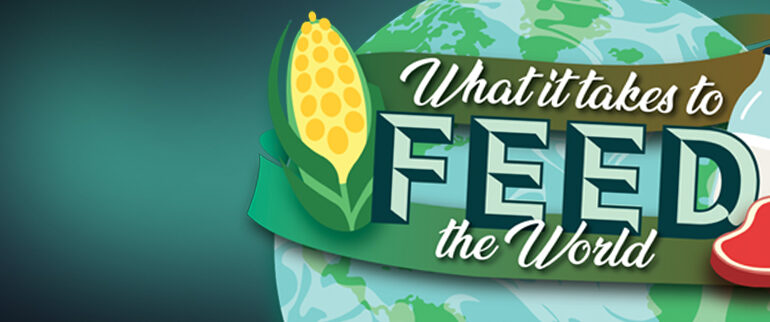
How Financial Institutions and Insurance Companies Play an Essential Role in Feeding the World
The cost of farming has grown over the years, which means financial institutions are amping up their reviewal process for loans and increasing insurance deductibles for protection to reduce their loss risk. What does this mean to supporting food production for the world? Well, as part of our “What It Takes To Feed The World” series, we are diving into critical agriculture sectors and bringing awareness to their roles in the food production cycle.
Financial institutions and insurance companies are the starting point in the process and are essential in providing the necessary funds to farmers on through to commercial entities. For farmers, they help finance EVERYTHING from the seed and chemical to hedge lines for farmers to help manage their price risk and everything in between. For commercial and end user entities, financing includes loans to build and maintain infrastructure and logistics to short term bridge loans to buy directly from farmers on to their own hedge lines of credit to support carrying of positions both pre and post harvest.
What financial and insurance options are available to the agriculture industry, and how are they beneficial to farmers, commercials, and end users? We’ll discuss the answers to these questions and more below.
Farmer Direct Loans
Farm direct loans are loans that the government makes available via the Farm Service Agency, while banks provide similar farmer direct loans. In 2021 the FSA reported loan obligations of $6.67 billion. Meanwhile, in 2020, U.S. farm banks loaned $98.6 billion. The American Bankers Association defines farm banks as banks whose ratio of domestic farm loans to total domestic loans is greater than or equal to the industry average. These amounts show just how much money is needed to produce the U.S. crop each year before farmers even harvest and sell the crop. These loans range from rent payments to fertilizer costs to machinery. But farm banks aren’t just offering loans to the agriculture sector. In 2020 total bank lending reached $174 billion in farm and ranch loans (including the $98.6 billion). These banks play a significant role with billions in small farm loans and even microloans. Small farm loans are less than $500,000, and microloans are less than $100,000. These two categories alone totaled over $55 billion in 2020.
Hedge Margin Lines
Banks also help finance hedge margin lines to help farmers manage their price risk. By financing the hedge lines, banks allow farmers to place hedge positions in a brokerage account, protecting against adverse price movements that could lessen the value of their crop. When banks loan out money, they expect to be paid back; hedge credit lines are a tool banks use to help support the farmer being able to do so. If your bank is NOT willing to extend a hedge line – please give us call!
By financing hedge margin lines, banks support the farmer and themselves. With loans comes default risk and hedging is one tool to help mitigate the price risk that ultimately will be how the farmer pays back the loan.
Banks and the Rest of the Sector
There’s no question that banks are involved in the food production supply chain. When you think about it, commercials, end-users, and other units that touch grain utilize bank loans to enhance their businesses. Like feed yards and elevators, end-users use banks to improve their infrastructure by adding more storage or drying systems, using short-term loans to purchase grain and make other improvements to their business. These improvements ultimately improve the efficiency of the entire system and potentially lead to reduced costs of the final product, which helps the end consumer, people. Just like improvements to city and towns infrastructure are necessary, through the support of bank financing, these improvements are necessary to the health of the agriculture industry’s infrastructure.
Farming is not getting any cheaper, and more capital is required to produce excellent crops year after year. Banks’ loaning capacities play a major role already, but if we are going to keep up with growing demand in a growing world, their role will be even more critical going forward.
Crop Insurance
Crop insurance brings continuity to the industry year-over-year as the ups and downs of weather and prices can cost farmers millions of dollars if unprotected. There are two types of insurance for major field crops: yield-based, which pays an indemnity (covers losses) for low yields, and revenue that ensures a level of crop income based on yields and prices.
Insurance offerings and prices vary on where you are located and your land, but like other forms of insurance in your life, it is better to have it and not need it than need it and not have it. While the listed above are the main types of insurance, others can be purchased, like drought insurance for pastureland and hail insurance if your crop gets damaged by an ice storm. These are more specific to your geographic location but play an essential role.
Like banks, insurance companies help with the continuity of the agriculture sector. These companies along with government subsidy programs, provide the opportunity to continue farming when disaster strikes and threatens the financial stability of a farm.
How RCM Ag Services Partners Financial Institutions & Insurance Companies
For our Farmer Direct customers, RCM Ag Services partners with banks and insurance companies to provide our mutual customers daily expert market knowledge and advice. We are firm believers that the long term health and growth of our local farming communities requires a team approach that starts with the farmers and their banking and insurance teams.
For our commercial and end user customers, we are focused on evaluating profit margins and the cost of capital for managing the current and futures market risks. Our Ag Services team is working directly with lenders, 3rd party credit suppliers, as well as USDA government programs to support the long-term financial health of the commercial business sector.
Along with market knowledge, our brokerage services allow us to establish hedge accounts that banks can fund with a credit line, as discussed above. Our brokers have over 150 years of combined experience in the market that helps them provide hedge advice that is customized to each operation, not cookie-cutter advice. Take advantage of these benefits and call one of our knowledgeable ag specialists today at 888-875-2110 or email [email protected]


Corn made small gains on the week as grains did well across the board. The forecast for South America can’t seem to make up its mind switching back and forth on rain amounts. Argentina has consistently had rain in the forecasts, but what parts of the country and the amount has been inconsistent. Exports were better this week than last, but nothing crazy; potential conflict in Ukraine and further issues with the South American crop could see those numbers pick up soon. The markets are not open for President Day on Monday the 21st, so there is more time to develop around the world. Based on the Dec ’22 futures for corn after today, the February insurance price is $5.84 ¾.


Soybeans were up slightly on the week but have been relatively flat (relative to other weeks) the last two weeks, as you can see in the chart below. The continued weather issues in South America and the Russia v Ukraine possible invasion have been the movers for beans just like corn and wheat. Bean exports this week were the best of the group, with a flash old crop sale being announced on Thursday. We have seen private estimates continue to roll in for production in South America and what to expect this year in the US. The USDA Ag Outlook Forum will start next Wednesday, and we should find out what they are expecting for the year ahead and how the US will affect balance sheets. The insurance price for beans is $14.22 ½.


Wheat has been on a roller coaster the last two months with the ups and downs and uncertainties around Russia and Ukraine. A Russia invasion would be bullish for wheat as countries would shy away from trade with Russia, and Ukraine would stop exports as they try to keep Russia at bay. The Black Sea is a major world trade region. This conflict could lead to potential stoppages, shortages, or even a possible blockade in the region that would cripple a major trade corridor. Keep an eye on this developing story as it could have potential long-term consequences as the US has also threatened Russia with sanctions (they don’t seem to be fazed at all by Washington’s threats).
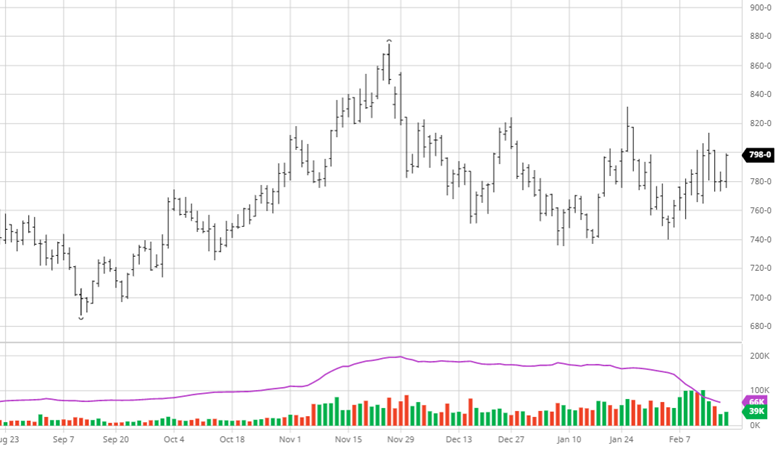

Dow Jones
This week, the equity markets fell as confusion and concerns of post-Olympic wars between a few countries inch closer. Russia was reported to have changed their mind on invading Ukraine, only for that news to switch to them adding troops at the border. China invading Taiwan post-Olympics is also a possibility as that has seemed to be forgotten as the Russia news took over the market. Earnings season has been mixed with losers and winners in all sectors as inflation has begun to show up more in guidance for the year ahead.

Podcast
Tune in as biotech guru Dr. Channa S. Prakash discusses everything from Alabama football, genetics as one of the most extensive agricultural advancements, the most significant risk factors to feeding the world over the next 30-50 years, plus everything in between.
Why producing crop plants with a much gentler footprint on the natural resources will help feed the growing population. How 75% of the world’s patents in agriculture gene editing are coming from China. Understanding that trying to impose restrictions on our ability to grow food can be a considerable risk to agriculture. Listen to hear about these topics and more!
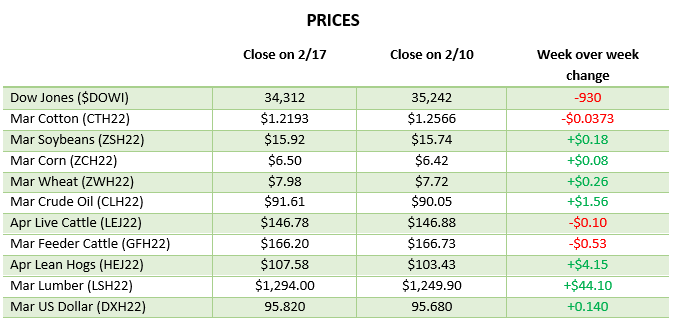
Via Barchart.com
Contact an Ag Specialist Today
Whether you’re a producer, end-user, commercial operator, RCM AG Services helps protect revenues and control costs through its suite of hedging tools and network of buyers/sellers — Contact Ag Specialist Brady Lawrence today at 312-858-4049 or [email protected].


The numbers came in above trade estimates but were lower than the previous months’ report. The USDA kept the U.S. ending stocks at 1.540 billion bushels and lowered the world ending stocks to 302.22 million tonnes while reducing Brazil’s yield. Following the report, it came off the highs for the day before roaring back up to end the day. Thursday’s trade was interesting as halfway through trading, the markets did a 180-degree turn and fell lower on the day after being sharply higher across the board for a large intraday range. This was brought on by producers selling and speculative positions taking profits. The large intraday volatility has not been as present in the market as this summer, but Thursday’s trade is a sign that volatility should be expected at these price levels. The USDA’s numbers for Brazil and Argentina are still above what private analysts and CONAB are reporting. The market seems to be on the analysts’ side when it comes to the struggles in South America. The weather outlook remains the same for the trouble areas as it will be hot and dry in the same areas and wet in the same.


Soybeans continued their run higher despite Thursday’s pullback. The most significant change in the report came to soybeans as the USDA lowered Argentina’s production by 1.5 million tonnes and Brazil’s 5 million. As much of a correction that the USDA made, some analysts still feel these are too high, and their crop will continue to get smaller. With the continued hot and dry weather in Argentina and southern Brazil mixed with the wet harvest in northern Brazil, mother nature is not doing South America’s crops any favors. CONAB released their estimates on Thursday and were well below the USDA numbers, so it’s safe to listen to their numbers and analysts over the USDA right now, it would appear. The two-year chart is below so that you can see the journey of how we got to this point with the great run since early November. Thursday produced the same wild volatility as corn, which saw a 67 ½ cent range while falling off the highs.


Dow Jones
The equity markets have been quieter lately, with small gains on the week, but the uncertainty of what lies ahead remains. The inflation number came in at 7.5% year over year, the highest increase since February 1982. With inflation sticking around and treasury yields jumping, the 10-year treasury topped 2% for the first time since August 2019; it is understandable why the markets have the jitters. Will the market hang out where it is, retest the lows, or try to continue to claw back its losses from January? The market can’t figure it out, so I won’t try to predict for you.

Podcast
Tune in as biotech guru Dr. Channa S. Prakash discusses everything from Alabama football, genetics as one of the most extensive agricultural advancements, the most significant risk factors to feeding the world over the next 30-50 years, plus everything in between.
Why producing crop plants with a much gentler footprint on the natural resources will help feed the growing population. How 75% of the world’s patents in agriculture gene editing are coming from China. Understanding that trying to impose restrictions on our ability to grow food can be a considerable risk to agriculture. Listen to hear about these topics and more!

Via Barchart.com
Contact an Ag Specialist Today
Whether you’re a producer, end-user, commercial operator, RCM AG Services helps protect revenues and control costs through its suite of hedging tools and network of buyers/sellers — Contact Ag Specialist Brady Lawrence today at 312-858-4049 or [email protected].
There was better trading in futures this week, but March opened the limit and locked. The back months had good volume, and July and Sept never hit the limit. At this point, you can exit your March shorts one way or another. That brings us to the next question: What does “life after limit” look like? If you take out the limit downs and the limit ups, we are sitting in the same area with the same dynamics. There is still good demand. Shipping out of the west is a mess, and trucking throughout North America is getting worse. And finally, we just moved closer to the Q2 buy.
The sell-off was a good indicator of a flow of wood through the system, and the rally right back indicates a continued fear that the flow will slow again. I think the industry is doing an excellent job keeping supplies flowing in. Since December, they have been buying “time” and fearing an upset chain. So today, it isn’t tomorrow’s ship time but rather next month’s ship time, and no one has that answer.
Any more bad news from the supply side will set the market off again, while any slowing in demand will force another sell-off. Buckle up….
Let’s Get Technical:
Elliot Wave is not voodoo economics, but that was funny. The biggest takeaway is that markets trade in waves, and in percentage terms, the lumber futures waves are easing in the distance. The corrective wave ran into support and a 20% RSI at a higher level this time down, keeping the cycle positive. We are looking for the top end where the market hits real resistance. Historically, the 1st quarter has strong support and weaker resistance areas, which is seasonal and consistent.
Weekly Round-Up:
$1,200 is not a happy medium, and the risk in both directions is substantial. We have never been in a place that could potentially have a $400 push up or $400 down. Time will ease the upside pressure, and the downside will be around for a while. Position accordingly.
Open Interest and Commitment of Traders:
https://www.cmegroup.com/daily_bulletin/current/Section23_Lumber_Options.pdf
About The Leonard Report
The Leonard Lumber Report is a new column that focuses on the lumber futures market’s highs and lows and everything else in between. Our very own, Brian Leonard, risk analyst, will provide weekly commentary on the industry’s wood product sectors.
Before You Go…
A special guest joins us for this episode of The Hedged Edge, who is well known for his many titles, which include Doctor, Editor-in-Chief, Dean, and Chief Academic Officer, just to name a few. Dr. Channa S. Prakash, Dean of the College of Arts and Sciences (CAS) at Tuskegee University, has served as faculty since 1989 and is a professor of crop genetics, biotechnology, and genomics. He is also well recognized for mentoring underrepresented minority students.
Tune in as biotech guru Dr. Prakash discusses everything from Alabama football, genetics as one of the most extensive agricultural advancements, the most significant risk factors to feeding the world over the next 30-50 years, plus everything in between. And as a bonus, we find out what sport he would be interested in playing if he went professional.


Corn suffered small losses this week, going a different direction than beans. Private estimates of the South American crop are consistently lower than the USDA’s last estimate, and we should see an adjustment on next week’s USDA report. The Chinese’s cancelation of 380,000 tonnes of corn was a drag on the market on Thursday. One cancelation is not the end of the world; it happens, but should we see a trend develop that could damper the bull sentiment right now. The driest areas of South America will continue to dry over the next couple of weeks, hurting their crop in those regions. Private estimates think that Argentina’s corn yield could be 43.5 million metric tons, while Brazil’s could be 112 MMT. These are well below the last USDA report’s numbers, so next week will be interesting to see how much the USDA adjusts their estimates.


Soybeans continued to move higher this week as the South American weather issues will probably significantly impact the soybean crop. The continued heat and dry weather will continue to stress the crop like corn. The market can’t go up every day, no matter what it seems like; the closing off the highs the last two trading days suggests the market may want to take a break until there is more news. Brazilian producers are still not selling, which has interior cash bids competitive with exporter bids. With this playing out in Brazil, the U.S. could see some more business as a result. Especially if China steps in and makes purchases out of the Pacific Northwest, keep an eye on drought conditions around the U.S. even though we are well out from planting as we have seen drier than normal weather in some growing areas to this point of the year.


Dow Jones
Equities have made a strong rebound off the lows until Thursday’s struggles following some bad earnings report lead by Facebook’s (now Meta) major fall. Amazon posted a good quarter which may give investors some relief that Facebook’s problems were their own and not market wide. The bounce was nice to see from an investors point of view as a correction seemed to be done, but guidance from many companies has not been as growth friendly looking forward as the last year. Volatility may stick around for a while so do not expect the markets to recover as quickly as they fell.

Crude Oil
Crude hit $90 this week for the first time since 2014, while Natural Gas also rose to over $5.500 before dipping back below $5 this week. Crude continues its move higher as OPEC+ does not plan to expand production while consumption remains strong. This is a classic higher demand without more supply price raise over the last two months, and many analysts see $100+/barrel as a possibility this spring. Higher fuel prices will affect farmers’ bottom lines as fuel expenses and shipping for other chemicals and fertilizers will be much higher this year on top of higher input costs. (5-year chart below for reference)
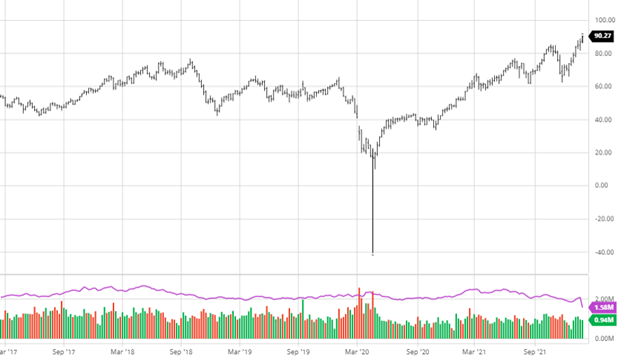
Feb USDA Report
The February WASDE report will be released next Wednesday, February 9. This will be the primary driver of the week after weekend weather has its say in the market on Monday. This is not usually a major market mover, but it never hurts to be well-positioned and ready before a report.
Podcast
Tune in as biotech guru Dr. Channa S. Prakash discusses everything from Alabama football, genetics as one of the most extensive agricultural advancements, the most significant risk factors to feeding the world over the next 30-50 years, plus everything in between.
Why producing crop plants with a much gentler footprint on the natural resources will help feed the growing population. How 75% of the world’s patents in agriculture gene editing are coming from China. Understanding that trying to impose restrictions on our ability to grow food can be a considerable risk to agriculture. Listen to hear about these topics and more!

Via Barchart.com
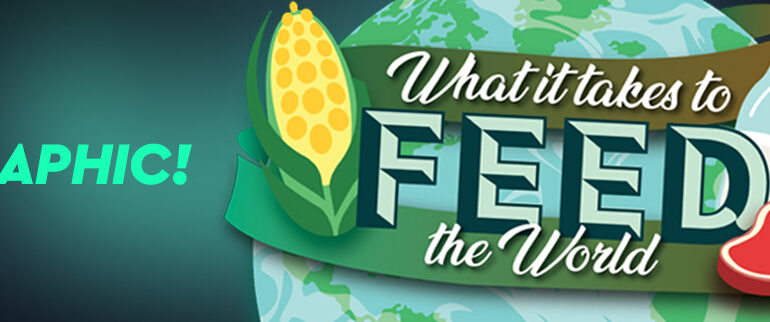
As of 2022, there are 7.9 billion people in the world, which is anticipated to hit 10 billion by 2050
Did you know that by 2050, the world is expected to feed almost 2 billion more people than we do today? As the global population continuously rises, a significant amount of food will need to be produced over the next 30 years.
But before you get to overwhelmed with that thought, it’s imperative to know that the need for more production creates opportunities. In fact, in 2020 alone, 19.7 million jobs were related to the agriculture and food sectors. We cover these areas in this What It Takes To Feed the World infographic. So, let’s take a closer look into how each of these categories work together to help pave the way to feeding 25% more of the population over the next couple of years. Here’s everything you’ll need to know:
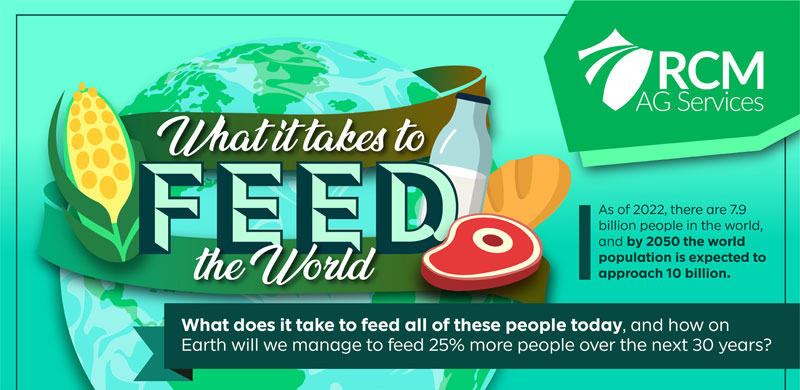
FINANCIAL INSTITUTIONS / INSURANCE
Due to inflation (we cover farm inflation here) and superior advancements in farming technology (seed, equipment, etc.), the cost of doing business is extraordinary.
As a result, banks and other financial institutions have become the pillar of the agriculture community. From financing farmers, purchase of seeds and chemicals to providing insurance to protect the farmers on through to commercial lending and trade finance programs; without banks, agriculture, as we know it today, does not exist. As a standalone example, consider that in the U.S. alone, during 2020, farm bank’ lending was $98.6 billion despite the global economic slowdown. As the demand to produce continues to grow, there is minimal question that the need for capital will grow along with it.
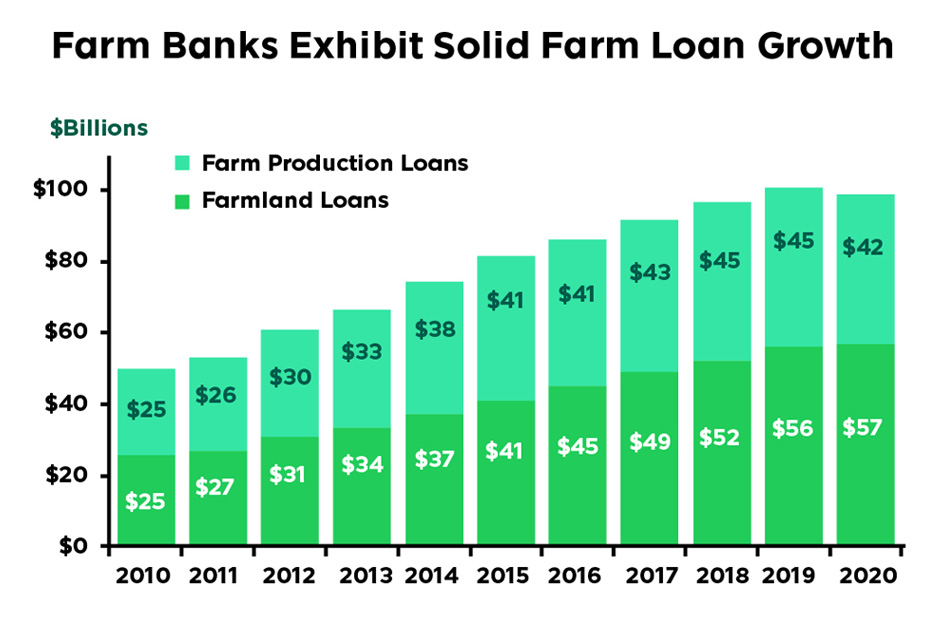
Source: Federal Deposit Insurance Corporation & American Bankers Association Analysis
SEED / CHEMICAL:
Before the farmers can get to work, they need seeds and, subsequently, fertilizers (watch our fertilizer forecast here) to reach the full potential of every acre of land. From the genetics to the production to the distribution companies, one could argue that continued innovation of this industry is vital to the future of agriculture.
In 2020, the commercial seed market alone reached an estimated $44.9 billion in annual revenue. With the global pressure on to produce, the world can no longer afford to have underperforming years of production, placing even more pressure on this sub-sector of agriculture to continue to develop treatments on both the organic and GMO sides (watch The Future of Feeding the World Podcast here).

Source: IHS Markit – @2021 IHS Markit
EQUIPMENT
With the growing demand for food-producing land due to the world’s growing population, advances in technology have seamlessly made the farming process more efficient, profitable, and undoubtfully safer. Modern farms and agriculture equipment have significantly evolved by incorporating sophisticated technologies like sensors and GPS to driverless equipment with new autonomous machinery.
These enhancements to heavy equipment are essential to farmers, allowing them to no longer apply certain things uniformly, like fertilizing or watering the field. But instead, farmers can use minimal effort to target specific areas of their fields. Let’s look at some of these added benefits due to technology:
Undoubtedly, innovation of this business sector will continue to evolve and play a major role in the necessary production increases ahead.
GRAIN PRODUCERS
One hundred fifty years ago, work was hard for grain producers, but the job was simple – till the land, plant the seed and let mother nature do her job. As time passed and our global population grew and the demand for our arable land has grown exponentially; all of which, leads to the grain producers of today having the most important job in the world.
The work of the few is to feed the many. Since the post-WWII era, the number of farms has steadily been reducing, placing even greater pressure on those in production areas to continue managing their operations, focusing on profit margins, and working the inherently volatile world of commodity prices.
Imagine a 5,000-acre farm producing trendline yield corn of 180 bushels per acre. Quick raw math based on today’s price per bushel of $6.00 puts gross revenue at 5.4 Million dollars. Noting the rapidly rising costs of inputs (seed and chemical), labor and energy prices, a return to August 2020 prices of $3 would be a massive hit and likely take down such an operation.
All of this is to say that today’s job requires greater collaboration with others in the business than ever before (see section below on intermediaries and risk management).
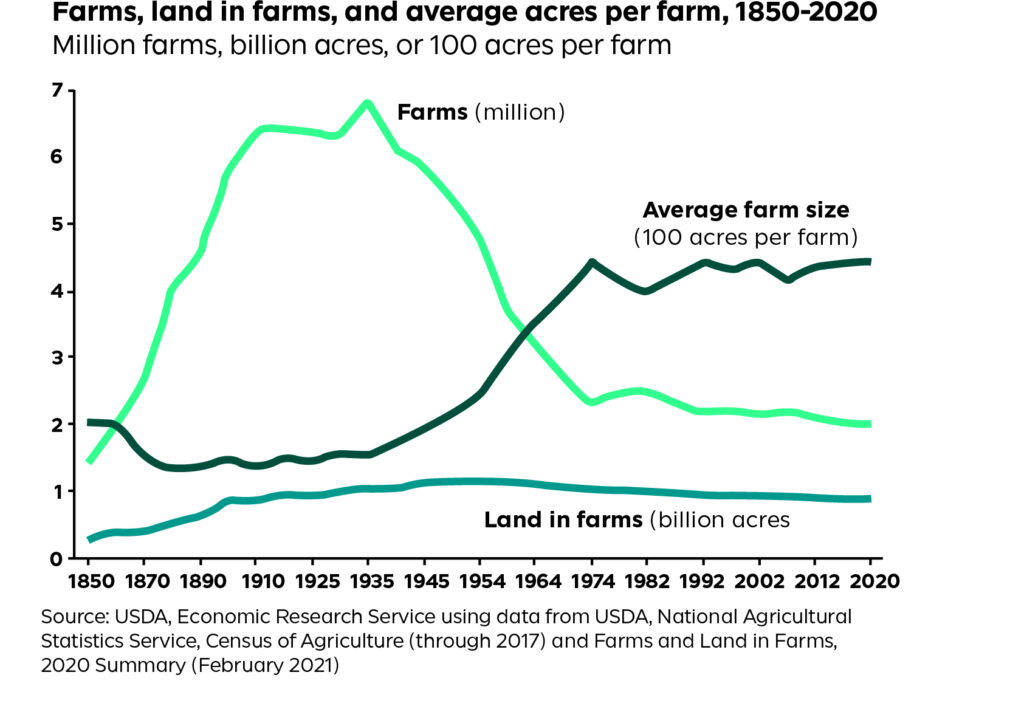
INTERMEDIARIES/RISK MANAGEMENT
Commodity markets are highly unique in that both end-users and physical producers of a product can proactively buy and sell their input and or production in an open market before being produced via a forward contract or hedge.
To hedge is to manage risk and, in most cases, lock in or protect the profits margins. As discussed above, grain production is a highly volatile business, just like the purchase side (see end-users and commercials below).
Through intermediaries and risk management experts, farmers and end-users gain timely market information, access to markets, and ultimately execute the majority of their forward pricing. Whether through the use of futures, options, swaps, or even physical contracts developing and coordinating a risk management plan is essential to the long-term health of our global commodity infrastructure.
The CME Group is the world-leading commodity exchange, and their global branding says it best – “CME Group, where the world comes to manage risk.”
RCM Ag Services also falls into this category. We provide full-service risk management and advisory solutions to our local area producers and commercial agriculture operations around the globe.
TRANSPORTATION/LOGISTICS
COVID introduced unexpected stresses on global food systems, creating many immediate and rapid challenges to secure food availability. If a worldwide pandemic taught us anything, we know that supply chain management and transportation play a vital role within the agriculture industry. Agriculture logistics ensure that items like food, machinery, and livestock from all over the world are transported with a continuous, optimal flow from the manufacturers and suppliers to the producers and ultimately delivered to consumers.
Some of the most imperative agriculture supply chain and logistics management activities include production, acquisition, storage, handling, transportation, and distribution. Effective logistics is critical for guaranteeing customer satisfaction and meeting demands on time with high-quality products. In addition, logistics should also meet specific standards and operational objectives for efficiency in agriculture policies like:
With the growing population largely expected in developing countries, most of which have poor infrastructure, we can expect the need for massive investments into transportation and logistics operations in the years ahead (this is NOT a stock tip!).
COMMERCIAL AND END USERS
The penultimate step of the process is grain reaching a commercial elevator before going on to the end-user to be converted to a final product. Some producers deliver straight to the end-user in areas where that is an option.
Traditionally, commercial elevators accept farmers’ grain and then ship it to the end-user, either by rail, barge, or other means.
With the continued upward trends of production, it is no surprise, that grain storage capacity has consistently grown. In fact, it is on pace with increases in crop production over the last 20 years and by all accounts is likely to continue to grow.
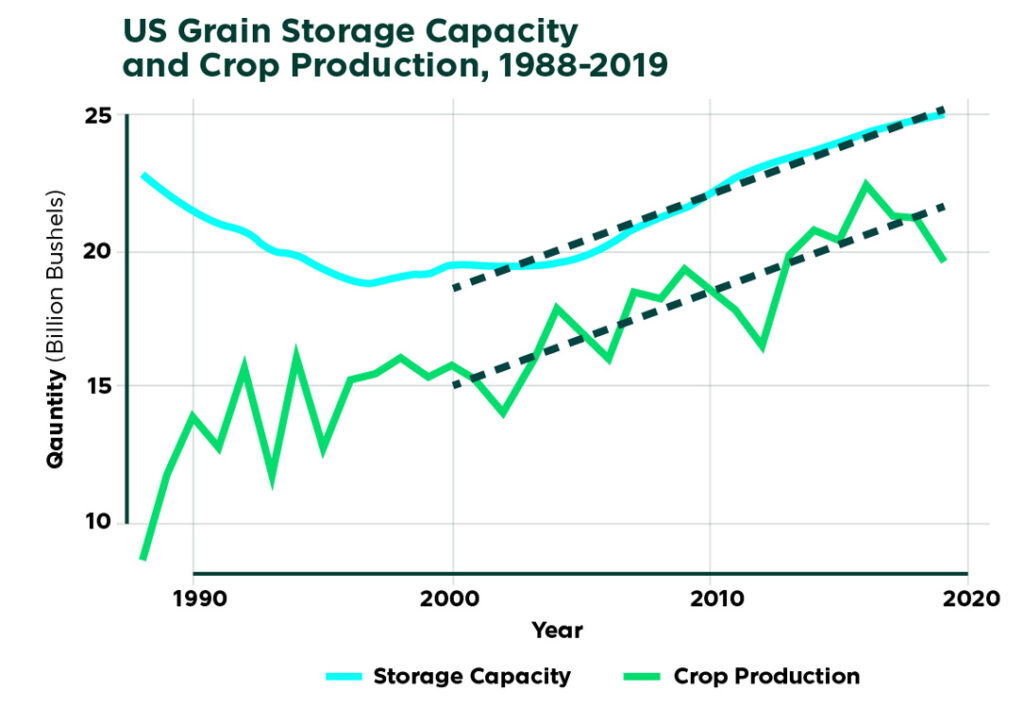
Source: Farmdocdaily
Along with the enormous capacity, commercials and end users also carry a tremendous amount of of price / volatility risk requiring a proactive and disciplined risk management approach to maximize the margins of their operation and keep the system moving forward.
In 2018, $139.6 billion worth of American agricultural products were exported worldwide, with elevators playing a significant role in that process. The commercials and end-users are essential for getting the product from the farm into your home on the table.
FEEDING THE WORLD IN THE FUTURE
Bringing awareness to how the agriculture industry is vital to feeding the rapidly growing world is pivotal as we continue to face unprecedented challenges in global food security. However, there is a silver lining. We already know what must be done; it is figuring out how to do it that could be problematic. The world must unite and understand that each of these areas highlighted in the infographic is very complex, employs millions of people worldwide, and is vital to the growth of the agriculture industry as well as producing the necessary food for the future.
CONTACT AN AG SPECIALIST TODAY
Whether you’re a producer, end-user, commercial operator, RCM AG Services helps protect revenues and control costs through its suite of hedging tools and network of buyers/sellers — Contact us today to speak with an ag specialist at 888-875-2110!